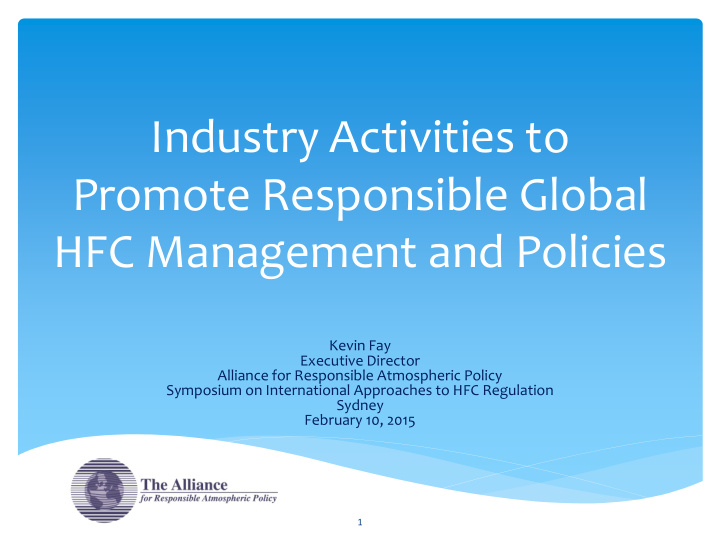



Industry Activities to Promote Responsible Global HFC Management and Policies Kevin Fay Executive Director Alliance for Responsible Atmospheric Policy Symposium on International Approaches to HFC Regulation Sydney February 10, 2015 1
The Alliance for Responsible Atmospheric Policy Industry coalition organized in 1980 Producers of fluorocarbons and industry sectors that manufacture products containing or utilizing fluorocarbons Formed originally to address stratospheric ozone depletion Transitioned to concurrently addressing climate change Currently represents more than 100 manufacturers and businesses, including their trade associations Promotes domestic and international policies that are environmentally beneficial and economically sensible www.alliancepolicy.org 2
At the Nexus of International Ozone Protection and Climate Discussions Accredited Non-Governmental Organization under the Montreal Protocol Accredited Non-Governmental Observer under the UN Framework Convention on Climate Change (UNFCCC) Accredited Non-State Actor in the Climate and Clean Air Coalition (CCAC) Part of the first industry group to join this international public- private organization Member of the International Climate Change Partnership 3
HFC Phasedown – Future Outlook In the Absence of a Global Regime Growth of Sub-global HFC Policies European F-gas Rule Japanese Voluntary F-gas Program Canadian Plans to Regulate HFCs – Based on SNAP Australian HFC Tax – Now Rescinded Growth of US Domestic HFC Policies and Influence of non-HFC Policies President Obama’s Climate Action Plan, includes HFCs – use of SNAP, Procurement Continuing Coverage of Energy Efficiency Regulations Inclusion of HFCs in Motor Vehicle Fuel Economy Regulations 4
Alliance has worked to advance policy proposals for responsible, effective HFC management January 2014 Filed petition with the US Environmental Protection Agency to extend ODS leak prevention regulations to HFCs (under CAA Sec. 608) Regulation and legislation to improve energy efficiency and promote low-GWP refrigerant technology only address new equipment entering the market place. 2/3 of HFC emissions occur as a result of commercial refrigeration and MAC system leaks and service practices. A much larger opportunity exists to make significant cost-effective emissions reductions from the existing installed base through effective refrigerant management practices today . 5
Towards Responsible Global HFC Management February 2014 Building on principles adopted in 2009/2010, Alliance announced its support for the negotiation of an HFC phasedown amendment to the Montreal Protocol March – August 2014 Held discussions with EPA and State Department regarding a comprehensive approach to dealing with the climate change contribution of HFCs 6
Towards Responsible Global HFC Management September 2014 – White House HFC Industry Roundtable Announced support for an amendment to the Montreal Protocol Pledged to take actions and support policies to achieve a global HFC emissions reduction of 80% by 2050 from current levels, relying on consumption as a surrogate for emissions. To achieve this objective: Significant individual corporate commitments to develop and implement low-GWP compounds and technologies, including investment of more than US$5 billion by US industry Work with EPA in development of improved refrigerant management practices Sponsor technology workshops to educate domestic and international audience on low-GWP compounds and technologies Participate in a task force on building codes and safety standards to expedite approval of utilization of new refrigerants that may be mildly flammable or flammable 7
Towards Responsible Global HFC Management September 2014 – United Nations Secretary- General’s Climate Summit Announced CCAC support for a global HFC phasedown under the Montreal Protocol and Gradual public procurement of low-GWP alternatives to HFCs when feasible Launched the Global Refrigerant Management Initiative Formed the Global Food Cold Chain Council October 2014 Participated in government-industry HFC workshops and discussions in India, Saudi Arabia, and China December 2014 - Present Coordinated US-India Task Force tour of Alliance member facilities Participating in US government-industry High Ambient Temperature TF 8
Developing Country Considerations Priorities Timing, Funding, and IP Self-determined phasedown schedules Importance of Political Changes in China and India Signals that countries are now willing to engage in actual negotiation Host Nation Leadership: UAE seeks a successful MOP, may submit proposal France interested in achievement prior to UNFCCC climate meeting at end of 2015 in Paris 9
North American and EU Phasedown Proposals Comparison of 2014 North American Amendment and EU Discussion Paper Schedules *Note: Only A5 phasedown schedule points defined in the EU discussion paper are for 2019 and 2045 10
Alliance Phasedown Priorities Predictability is important Global cap and phasedown is preferable to sub-global HFC policies Montreal Protocol process and institutions have worked well and provide the best opportunity for fair consideration of technical and economic issues Baseline should reflect actual demand Phasedown targets should be guided by reviews of actual technology availability Starting point should be based on “entry into effect” dates Schedule needs to take into account existing base servicing, sectors w/o alternatives Delays for developing countries are appropriate Global controls should not disadvantage developed country industry Funding for implementation in developing countries is important Domestic regulations should be consistent with global objectives. In the US, the HCFC-22 loophole should be closed. 11
Range of Emissions Reduction Opportunities Linear (US Market Estimate) 12
Range of Emissions Reduction Opportunities Two Step Linear (US Market Estimate) 13
Key Issues for the Alliance Definition of “gradual phasedown” Impact of building codes and safety standards process Availability of alternatives Regional technology advances Timing is critical AREP and other industry programs Regulatory overreach and economically disruptive domestic policies Consequences of domestic political landscape Effective development and implementation of refrigerant management programs and policies Coordination with energy efficiency policies 14
Questions? Kevin Fay Executive Director Alliance for Responsible Atmospheric Policy fay@alliancepolicy.org +1 (703) 243-0344 15
Recommend
More recommend